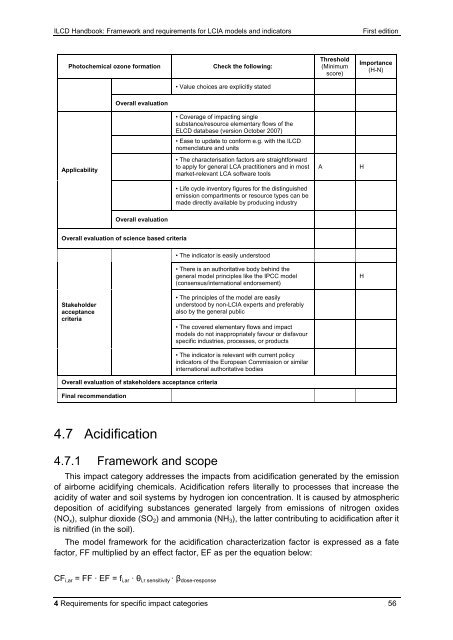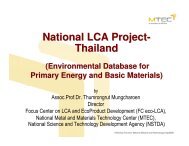ILCD Handbook: Framework and requirements for LCIA models and ...
ILCD Handbook: Framework and requirements for LCIA models and ...
ILCD Handbook: Framework and requirements for LCIA models and ...
Create successful ePaper yourself
Turn your PDF publications into a flip-book with our unique Google optimized e-Paper software.
<strong>ILCD</strong> <strong>H<strong>and</strong>book</strong>: <strong>Framework</strong> <strong>and</strong> <strong>requirements</strong> <strong>for</strong> <strong>LCIA</strong> <strong>models</strong> <strong>and</strong> indicators First edition<br />
Photochemical ozone <strong>for</strong>mation Check the following:<br />
Applicability<br />
Overall evaluation<br />
Overall evaluation<br />
Overall evaluation of science based criteria<br />
Stakeholder<br />
acceptance<br />
criteria<br />
Overall evaluation of stakeholders acceptance criteria<br />
Final recommendation<br />
4.7 Acidification<br />
4.7.1 <strong>Framework</strong> <strong>and</strong> scope<br />
• Value choices are explicitly stated<br />
• Coverage of impacting single<br />
substance/resource elementary flows of the<br />
ELCD database (version October 2007)<br />
• Ease to update to con<strong>for</strong>m e.g. with the <strong>ILCD</strong><br />
nomenclature <strong>and</strong> units<br />
• The characterisation factors are straight<strong>for</strong>ward<br />
to apply <strong>for</strong> general LCA practitioners <strong>and</strong> in most<br />
market-relevant LCA software tools<br />
• Life cycle inventory figures <strong>for</strong> the distinguished<br />
emission compartments or resource types can be<br />
made directly available by producing industry<br />
• The indicator is easily understood<br />
• There is an authoritative body behind the<br />
general model principles like the IPCC model<br />
(consensus/international endorsement)<br />
• The principles of the model are easily<br />
understood by non-<strong>LCIA</strong> experts <strong>and</strong> preferably<br />
also by the general public<br />
• The covered elementary flows <strong>and</strong> impact<br />
<strong>models</strong> do not inappropriately favour or disfavour<br />
specific industries, processes, or products<br />
• The indicator is relevant with current policy<br />
indicators of the European Commission or similar<br />
international authoritative bodies<br />
Threshold<br />
(Minimum<br />
score)<br />
A H<br />
Importance<br />
(H-N)<br />
This impact category addresses the impacts from acidification generated by the emission<br />
of airborne acidifying chemicals. Acidification refers literally to processes that increase the<br />
acidity of water <strong>and</strong> soil systems by hydrogen ion concentration. It is caused by atmospheric<br />
deposition of acidifying substances generated largely from emissions of nitrogen oxides<br />
(NOx), sulphur dioxide (SO2) <strong>and</strong> ammonia (NH3), the latter contributing to acidification after it<br />
is nitrified (in the soil).<br />
The model framework <strong>for</strong> the acidification characterization factor is expressed as a fate<br />
factor, FF multiplied by an effect factor, EF as per the equation below:<br />
CFi,ar = FF · EF = fi,ar · θi,r sensitivity · βdose-response<br />
4 Requirements <strong>for</strong> specific impact categories 56<br />
H



